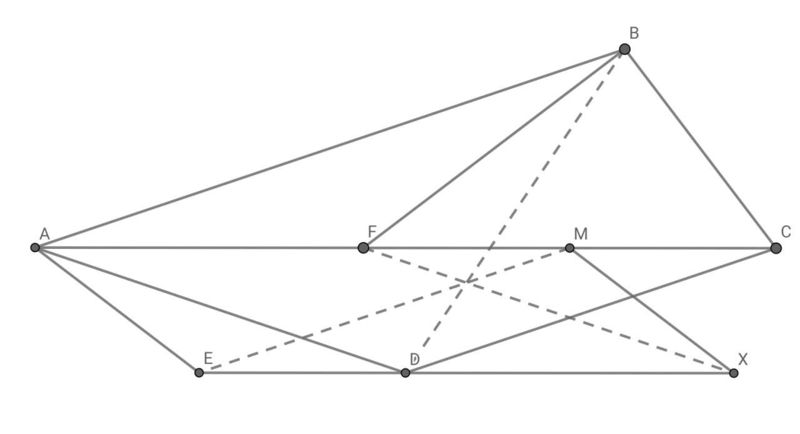Difference between revisions of "2016 IMO Problems/Problem 1"
m (→Solution 2) |
m (→Solution 2) |
||
| Line 20: | Line 20: | ||
Let <math>\angle FBA = \angle FAB = \angle FAD = \angle FCD = \alpha</math>. And WLOG, <math>MF = 1</math>. Hence, <math>CF = 2</math>, | Let <math>\angle FBA = \angle FAB = \angle FAD = \angle FCD = \alpha</math>. And WLOG, <math>MF = 1</math>. Hence, <math>CF = 2</math>, | ||
| − | <math>\implies</math> <math>BF = 2.cos(2\alpha) = FA</math>, | + | <math>\implies</math> <math>BF = CF.cos(2\alpha) = 2.cos(2\alpha) = FA</math>, |
| − | <math>\implies</math> <math>DA = \frac{AC}{2cos(\alpha)} = \frac{1+cos(2\alpha)}{cos(\alpha)}</math> and | + | <math>\implies</math> <math>DA = \frac{AC}{2cos(\alpha)} = \frac{CF+FA}{2cos(\alpha)} = \frac{2+2cos(2\alpha)}{2cos(\alpha)} = \frac{1+cos(2\alpha)}{cos(\alpha)}</math> and |
<math>\implies</math> <math>DE = AE = \frac{DA}{2cos(\alpha)} = \frac{1+cos(2\alpha)}{2.(cos(\alpha))^2} = 1</math>. | <math>\implies</math> <math>DE = AE = \frac{DA}{2cos(\alpha)} = \frac{1+cos(2\alpha)}{2.(cos(\alpha))^2} = 1</math>. | ||
| Line 30: | Line 30: | ||
<math>\angle MBF = \angle MFB = 2\alpha</math> and <math>\angle MXD = \angle MDX = 2\alpha</math> and we have seen that <math>MB = MF = MD = MX</math>, so <math>BFDX</math> is isosceles trapezoid. And we know that <math>ME</math> bisects <math>\angle FMD</math>, so <math>ME</math> is the symmetrical axis of <math>BFDX</math>. | <math>\angle MBF = \angle MFB = 2\alpha</math> and <math>\angle MXD = \angle MDX = 2\alpha</math> and we have seen that <math>MB = MF = MD = MX</math>, so <math>BFDX</math> is isosceles trapezoid. And we know that <math>ME</math> bisects <math>\angle FMD</math>, so <math>ME</math> is the symmetrical axis of <math>BFDX</math>. | ||
| − | + | <math>B</math> and <math>X</math>, <math>D</math> and <math>E</math> are symmetrical respect to <math>ME</math>. Hence, the symmetry of <math>BD</math> with respect to <math>ME</math> is <math>FX</math>. And we are done <math>\blacksquare</math>. | |
~EgeSaribas | ~EgeSaribas | ||
Revision as of 12:16, 19 May 2024
Contents
[hide]Problem
Triangle ![]() has a right angle at
has a right angle at ![]() . Let
. Let ![]() be the point on line
be the point on line ![]() such that
such that ![]() and
and ![]() lies between
lies between ![]() and
and ![]() . Point
. Point ![]() is chosen so that
is chosen so that ![]() and
and ![]() is the bisector of
is the bisector of ![]() . Point
. Point ![]() is chosen so that
is chosen so that ![]() and
and ![]() is the bisector of
is the bisector of ![]() . Let
. Let ![]() be the midpoint of
be the midpoint of ![]() . Let
. Let ![]() be the point such that
be the point such that ![]() is a parallelogram. Prove that
is a parallelogram. Prove that ![]() and
and ![]() are concurrent.
are concurrent.
Solution
The Problem shows that
And
Finally
~Athmyx
Solution 2
Let ![]() . And WLOG,
. And WLOG, ![]() . Hence,
. Hence, ![]() ,
,
![]()
![]() ,
,
![]()
![]() and
and
![]()
![]() .
.
So ![]() which means
which means ![]() ,
, ![]() ,
, ![]() and
and ![]() are concyclic. We know that
are concyclic. We know that ![]() and
and ![]() , so we conclude
, so we conclude ![]() is parallelogram. So
is parallelogram. So ![]() . That means
. That means ![]() is isosceles trapezoid. Hence,
is isosceles trapezoid. Hence, ![]() . By basic angle chasing,
. By basic angle chasing,
![]() and
and ![]() and we have seen that
and we have seen that ![]() , so
, so ![]() is isosceles trapezoid. And we know that
is isosceles trapezoid. And we know that ![]() bisects
bisects ![]() , so
, so ![]() is the symmetrical axis of
is the symmetrical axis of ![]() .
.
![]() and
and ![]() ,
, ![]() and
and ![]() are symmetrical respect to
are symmetrical respect to ![]() . Hence, the symmetry of
. Hence, the symmetry of ![]() with respect to
with respect to ![]() is
is ![]() . And we are done
. And we are done ![]() .
.
~EgeSaribas
See Also
| 2016 IMO (Problems) • Resources | ||
| Preceded by First Problem |
1 • 2 • 3 • 4 • 5 • 6 | Followed by Problem 2 |
| All IMO Problems and Solutions | ||











